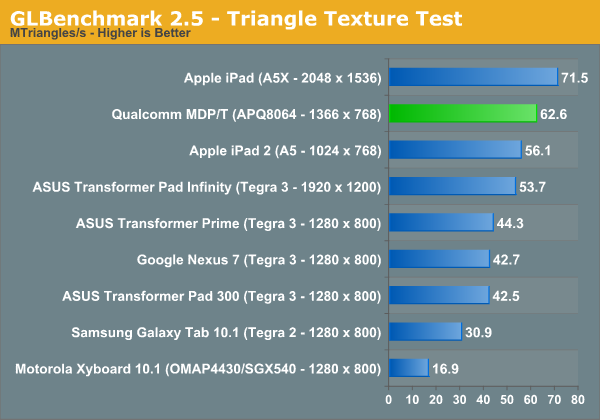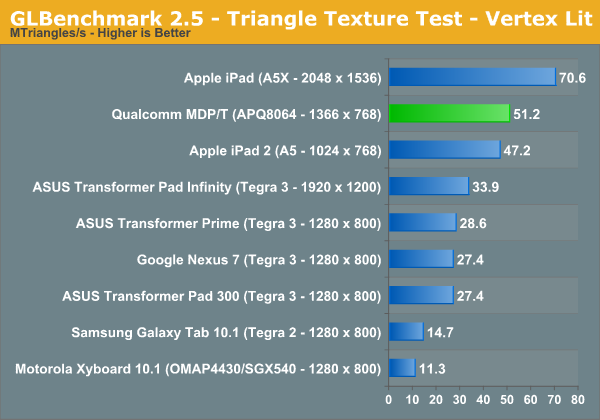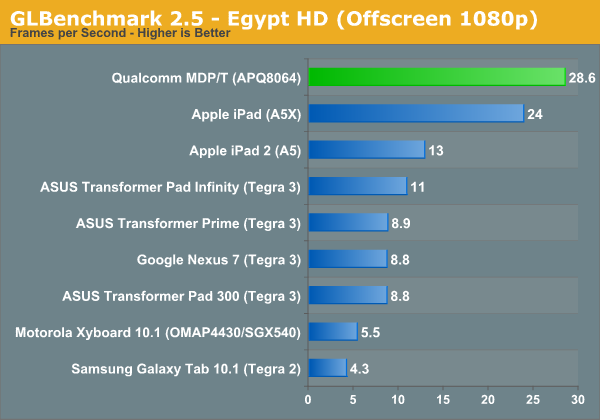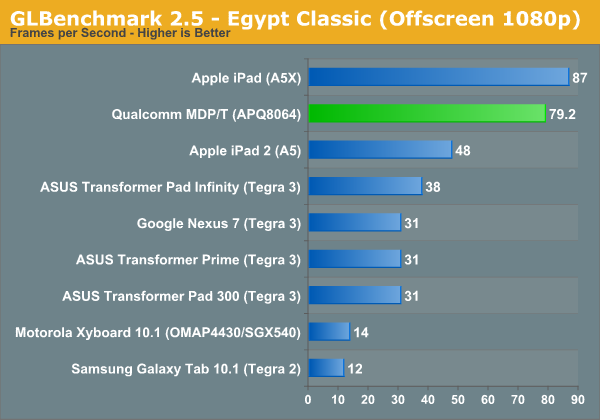Qualcomm's APQ8064 and GLBenchmark 2.5 - MDP/T Results
by Brian Klug & Anand Lal Shimpi on August 24, 2012 4:33 PM ESTA month ago Qualcomm invited us to play with their latest mobile development platform, the APQ8064 based MDP/T. For those of you who have trouble following Qualcomm's naming scheme, the APQ prefix implies an SoC without integrated baseband. The 8064 corresponds to a 28nm, quad-core, Krait v2 based SoC. All of the cores can independently clock as high as 1.5GHz. Running alongside the four Krait cores is Qualcomm's Adreno 320 GPU, the first member of its next-generation graphics architecture. We went into a bit of detail on the 320 here, but architectural details on the 320 as well as clock speeds are scarce at this point.
This wasn't the first Qualcomm MDP we played with, but it was the first one we benchmarked in the form of a tablet. These platforms are built as test vehicles for Qualcomm silicon, usually acting as a showcase for what the hardware can do. Just as important however is using these MDPs to build, test and optimize Android for Qualcomm's silicon. Although we had to leave the MDP/T in San Diego, our own test unit from Bsquare just showed up, giving us the opportunity to look at Adreno 320 performance in GLBenchmark 2.5.
As a recap, the APQ8064 MDP/T features a 1366 x 768 screen, 2GB of LPDDR2-1066 (2x32-bit channels) and runs Android 4.0.4. GLBenchmark 2.5 is the latest Kishonti GPU test for Android and iOS. We went through and outlined the changes to GLBenchmark 2.5 in our launch article. Note that not all GLBenchmark 2.5 tests completed on our MDP/T, what you see below is all we could get to complete. As this is a development platform, things are sometimes rough around the edges. Finally, as always, we are looking at performance of a development platform. A lot can happen in the transition to final, shipping hardware, that can change performance. Qualcomm's most recent MDPs ended up performing pretty close to OEM hardware, but anything is possible (particularly as the OEM has final say in the software configuration of their devices).

Without details on the GPU clock it's tough to conclude a lot about the fill rate test results, but Adreno 320 does very well. Hot on the heels of the PowerVR SGX 543MP2, the 320 is a significant improvement over the current crop of GPUs running Android.

GLBenchmark's simplest triangle test puts the Adreno 320 in between the performance of the 2nd and 3rd gen iPads.


Here's where the 3rd gen iPad's resolution penalizes it, the 2nd gen iPad pulls ahead and the MDP/T ends up faster than both. It's unfortunate the offscreen tests wouldn't complete properly.

At its native resolution in the new Egypt HD gameplay simulation test, the Adreno 320 based MDP/T does incredibly well. Part of the explanation is the Adreno 320 seems a bit overpowered for the MDP/T's 1366 x 768 display. When we normalize display resolution to 1080p the MDP/T is still in the lead, but the margin of victory seems more believable:

This is great performance from the MDP/T. When we first looked at GLBenchmark 2.5 we were worried that it'd be another generation before we got reasonable frame rates out of mobile hardware, but if the MDP/T is any indication that time may be sooner rather than later.

The only Egypt classic test that would complete is the offscreen 1080p benchmark, which is perfect as it gives us data normalized to a single resolution. Here the A5X pulls ahead by around 10% but once again the MDP/T does extremely well. If Qualcomm's device partners can match the MDP/T with shipping hardware, the next generation of Android tablets should have pretty good GPU performance.
















9 Comments
View All Comments
zanon - Friday, August 24, 2012 - link
Looks like a solid improvement over previous gen Android GPUs, but we still aren't seeing another big generational leap yet. Any word on that status of Series 6 in SoCs? I can't seem to find anything of substance since the CES announcement of the G6200 and G6400, but they certainly sound promising.Hunt3rj2 - Saturday, August 25, 2012 - link
Series 6 will probably arrive either with the Novathor Cortex A15 SoCs, or with Apple's A6.Either way, I have a feeling that the OMAP 5 and the A5x are going to be an accurate picture of the GPU performance for this generation, mostly because it seems to be that most other tablets and phones won't be needing the GPU muscle that the iPad 3 did.
MartinT - Saturday, August 25, 2012 - link
What's to keep any company from massaging any of these well-know benchmarks? And on these fully closed platforms, would there be any way to detect that?Hunt3rj2 - Saturday, August 25, 2012 - link
The fact that a whole trio of LG phones with Adreno 320s are right up there in benchmarks on the GLBenchmark website?There's literally at least 3 phones from LG that have been benchmarked with Adreno 320s, and some have even higher FPS than the MDP.
lilmoe - Saturday, August 25, 2012 - link
You guys are missing a huge factor that probably makes the Adreno 320 faster than PowerVR 5 series and that's TDP. The power consumption of the PowerVR SGX543MP4 is just too high in comparison with other tablet SoCs and a valid comparison between the speed of the two isn't exactly possible ATM. Not to mention that both SoCs are on different process anyway (28nm vs 45nm). It would be a different story if the overall TDP of the APQ 8064 is equal to that of the current A5X when the GL benchmark is running. Any company out there can make a faster GPU than currently available, but it's not too easy when the max TDP is close to 1w.A better comparison is if the next iPhone comes with the same A5X chip built on Samsung's 32nm process and a slightly slower clock (like we've seen before from Apple) to match the current TDP of the A5 chip found in the iPhone 4S. The power constraints on a smartphone SoC are more restricting. If so, a better comparison would be possible, and that's for the new iPhone vs whatever smartphone comes equipped with the Adreno 320 GPU.
Right now, I'd give the APQ 8064 the performance advantage, the GPU is NOT the sole defining factor of performance in either apps or games, not even for the UI; The CPU also factors in. Physics, some forms of rendering, sound, touch, sensors, and lots of other stuff currently depend on the CPU in current generation (even next generation) SoCs, these also factor in a huge difference in game play and application run speeds and usability. I believe the APQ 8064 gives a more "balanced" performance ratio than the A5X, and will most probably make the entire package run faster on any given load, all while having a smaller power footprint.
Arnulf - Saturday, August 25, 2012 - link
So ... when are we going to see this thing on desktop (low power non-x86 based PCs) ? Judging by these figures it should be possible to get 2007 era PC performance in thermal budget of a 1993 486-based PC ... passive cooling, able to run 3D games, play media, perform office chores etc. This thing makes Atom look like a bad joke.ImSpartacus - Sunday, August 26, 2012 - link
ARM solutions are definitely surging forward, but Atom isn't in neutral. It's hard to say which will dominate the other in the coming years, but I'd be surprised if they aren't at least competitive with each other.A5 - Sunday, August 26, 2012 - link
Atom still slaughters these ARM CPUs when it comes to CPU-based benchmarks like web browsing and whatnot. Of course the price you pay is a TDP that is an order of magnitude higher, but even Krait isn't really competitive with Atom on a pure CPU performance level.Pipperox - Sunday, August 26, 2012 - link
What are you talking about?There was a single benchmark where Atom came out on top (Sunspider) for a while, and that is a where sw optimizations on the browser side play the dominant role.
I won't link here to competing websites, but if you did a small search you'd see that Medfield based phones offer a level of performance comparable to dual core A9, while Krait or quad core Exynos simply "slaughter" it, to use your words.